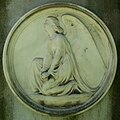Robert Cauer the Elder
Robert Cauer the Elder Ä. (* February 13, 1831 in Dresden ; † April 2, 1893 in Kassel ) was a German sculptor .
Life
Robert Cauer the Elder was the son of Emil Cauer the Elder . Ä. and brother of Karl Cauer . The Cauers are an extensive family of artists, primarily sculptors - a profession that his sons Stanislaus and Friedrich Cauer also took up. The nephew Hans Cauer was also a painter, the nephews Emil and Hugo Cauer , sons of the brother Karl, were sculptors.
Born in Dresden , he received his first lessons from his father in Kreuznach . From 1851 to 1856 he studied painting at the Düsseldorf Art Academy with Wilhelm von Schadow and Karl Ferdinand Sohn , in the meantime (1853/54) also at the academy's building school, under Rudolf Wiegmann . He was friends with the budding painters Ernst Bosch , Hubert Salentin and Carl Thiel , with whom he lived together. From 1851 to 1857 he was also a member of the Malkasten artists' association . Through further instruction from his father in Kreuznach, he switched back to sculpture without giving up painting and drawing entirely. Between 1856 and 1858 he made trips to Dresden and Berlin, England and Scotland. From 1856 to 1861 he stayed several times in Rome, where he settled in 1882 until shortly before his death. Together with his brother Karl, he set up a studio here in 1883 and ran another in Kreuznach . In Rome he advised and supervised the German Rome scholarship recipients in the Villa Strohl-Fern from 1887 onwards on the official order of the Prussian government . In 1888 the Prussian Ministry of Education appointed him professor. From 1889 he lived alternately in Rome and Kassel. His portrait bust was created by his nephew Ludwig Cauer ; a portrait drawing by Carl Thiel and an anonymous caricature are kept by the artists' association Malkasten in Düsseldorf.
plant
In his early paintings, Cauer dealt with subjects such as “ Rübezahl ” or “ Playing Children ”, but as a sculptor he occasionally selected motifs from literature, including “ Hermann and Dorothea ”, “ Paul and Virginie ”, “ Loreley ”, and in particular the fairy tales of the Brothers Grimm, for example " Sleeping Beauty ", " Snow White " or " Puss in Boots ". The sculptures that emulated his father's work - “ Venus and Cupid ”, “ Venus with Dolphin ” or the numerous portrait plaques - were more oriented towards classical antiquity .
Cauer was best known as the creator of important portrait sculptures and grave monuments, including several in the Old Cemetery in Bonn , for example those by Friedrich Wilhelm August Argelander , Paula Doetsch and Nikolaus Simrock . In 1876, Cauer created the grave of Maximilian Freiherr Roth von Schreckenstein in the cemetery of honor in the German-French garden in Saarbrücken. In 1872 the marble sculpture "Sleeping Girl" was created.
literature
- Friedrich Back : Cauer, Robert d. Ä. In: Ulrich Thieme (Hrsg.): General Lexicon of Fine Artists from Antiquity to the Present . Founded by Ulrich Thieme and Felix Becker . tape 6 : Carlini-Cioci . EA Seemann, Leipzig 1912, p. 200–201 ( Textarchiv - Internet Archive ).
- Hyacinth Holland : Cauer, Robert the Elder . In: Allgemeine Deutsche Biographie (ADB). Volume 47, Duncker & Humblot, Leipzig 1903, p. 467 f.
- Hans Wolfgang Singer (Ed.): General artist lexicon. Life and works of the most famous visual artists , prepared by Hermann Alexander Müller. Volume 1. Literary Institute Rütten & Loening, Frankfurt / Main 1921.
- Emanuel Bénézit (Ed.): Dictionnaire Critique et Documentaire des Peintres, Sculpteurs, Dessinateurs et Graveurs de tous les temps et de tous les pays. Volume 2, 1976
- Hans Paffrath (Ed.): Lexicon of the Düsseldorf School of Painting 1819–1918. Volume 1: Abbema – Gurlitt. Published by the Kunstmuseum Düsseldorf in the Ehrenhof and by the Paffrath Gallery. Bruckmann, Munich 1997, ISBN 3-7654-3009-9 , p. 224.
- Robert Cauer the Elder . In: General Artist Lexicon . The visual artists of all times and peoples (AKL). Volume 17, Saur, Munich a. a. 1997, ISBN 3-598-22757-4 , p. 334.
- Josef Niesen : Bonn Personal Lexicon. 3rd, improved and enlarged edition. Bouvier, Bonn 2011, ISBN 978-3-416-03352-7 .
gallery
Tondo for the tombstone of Karl Simrock , Alter Friedhof Bonn
Gravestone of Friedrich Wilhelm August Argelander , Bonn old cemetery
Tondo for the tombstone of Friedrich Gottlieb Welcker , Alter Friedhof Bonn
Tondo for the gravestone of Ludwig Schopen, Alter Friedhof Bonn
Grave angel for Paula Doetsch, Bonn old cemetery
Tondo for the Schaaffhausen grave , Bonn old cemetery
Prometheus in the palace gardens of Schloss Dhaun
Web links
- Robert Cauer (I). Biographical data and works in the Netherlands Institute for Art History (Dutch)
- Cauer, Robert the Elder. Hessian biography. (As of February 13, 2020). In: Landesgeschichtliches Informationssystem Hessen (LAGIS).
- Entry on Robert Cauer the Elder in the Rhineland-Palatinate personal database
Individual evidence
- ^ Siegfried Weiß : Ernst Bosch (1834–1917), Life and Work: on Düsseldorf painting of the 2nd half of the 19th century. Diss. Univ. Munich 1992.
- ↑ To the Chronicle of the Academy. From August 1884 to the end of March 1886. In: Illustrated catalog: Exhibition of the Royal Academy of Arts in Berlin in the state exhibition building: Jubilee exhibition of the Kgl. Akademie der Künste in the state exhibition building in Berlin: from May to October 1886, illustrated catalog, Berlin, 1886.
| personal data | |
|---|---|
| SURNAME | Cauer, Robert the Elder |
| ALTERNATIVE NAMES | Cauer, Robert the Elder Ä. |
| BRIEF DESCRIPTION | German sculptor |
| DATE OF BIRTH | February 13, 1831 |
| PLACE OF BIRTH | Dresden |
| DATE OF DEATH | April 2, 1893 |
| Place of death | kassel |










